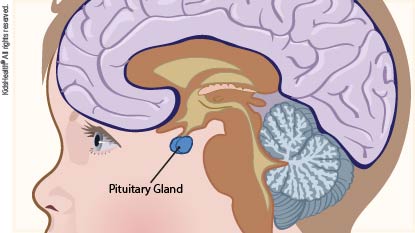- Parents Home
- Para Padres
- A to Z Dictionary
- Allergy Center
- Asthma
- Cancer
- Diabetes
- Diseases & Conditions
- Doctors & Hospitals
- Emotions & Behavior
- First Aid & Safety
- Flu (Influenza)
- Food Allergies
- General Health
- Growth & Development
- Heart Health & Conditions
- Homework Help Center
- Infections
- Newborn Care
- Nutrition & Fitness
- Play & Learn
- Pregnancy Center
- Preventing Premature Birth
- Q&A
- School & Family Life
- Sports Medicine
- Teens Home
- Para Adolescentes
- Asthma
- Be Your Best Self
- Body & Skin Care
- Cancer
- Diabetes
- Diseases & Conditions
- Drugs & Alcohol
- Flu (Influenza)
- Homework Help
- Infections
- Managing Your Weight
- Medical Care 101
- Mental Health
- Nutrition & Fitness
- Q&A
- Safety & First Aid
- School, Jobs, & Friends
- Sexual Health
- Sports Medicine
- Stress & Coping
Craniopharyngioma
What Is a Craniopharyngioma?
A craniopharyngioma is a rare type of benign (not cancerous) brain tumor. These tumors usually form close to the and do not spread to other areas.
Doctors usually can remove these tumors with surgery. In some cases, complete removal is not possible and radiation may be needed.
What Happens With a Craniopharyngioma?
A craniopharyngioma (kray-nee-oh-fair-in-jee-OH-muh) can grow and push on the things around it, including:
- the pituitary gland
- the optic tracts
- the third ventricle of the brain
Each of those parts help a child grow and thrive:
- The pituitary gland makes hormones that help a child's body:
- grow well
- change from a child into an adult
- maintain the right blood pressure
- The optic tracts connect the optic nerves from the eyes to the brain, so a child can see.
- The third ventricle of the brain is a fluid-filled space that connects with other fluid-filled spaces in and around the brain. The fluid in these spaces:
- protects the brain from jolts and hits to the head
- carries nutrients and gets rid of waste
When a craniopharyngioma pushes on these parts, they don't work well, so a child starts to have symptoms.

What Are the Signs & Symptoms of a Craniopharyngioma?
When a craniopharyngioma grows and presses on the areas around it, a child might:
- have headaches
- have trouble seeing things to the far left and far right
- have poor balance or trouble walking
- have nausea and vomiting
The child also may:
- need to drink more than usual
- need to pee more often than usual
- not go through the usual changes of puberty
- grow slowly or not grow
- not start having periods (menstruation)
- have low blood pressure
- be more tired than usual or sleep a lot
- act differently (have a personality change)
What Causes Craniopharyngioma?
Experts think that craniopharyngiomas grow from leftover pieces of tissue that didn't disappear as expected in early pregnancy when the baby's head, face, and brain are forming.
Who Gets Craniopharyngioma?
Most craniopharyngiomas happen in kids 5 to 14 years old. But they can affect people of any age.
How Are Craniopharyngiomas Diagnosed?
Usually, parents notice one or more of the symptoms of a craniopharyngioma and take their child to a doctor. Other things can cause similar symptoms, so the doctor will:
- ask questions about the symptoms and other medical problems (medical history)
- do an exam
- order blood tests to measure mineral and hormone levels
- do imaging tests, including CAT scan or MRI
Other tests done can include:
- a lumbar puncture (spinal tap)
- a biopsy to test a sample of the tissue. This can involve:
- surgery through an opening in the skull
- minimally invasive techniques through the nose or through a needle inserted through a small hole in the skull
How Is Craniopharyngioma Treated?
A team of specialists works together to treat a craniopharyngioma. They include experts in:
- brain and spinal cord disorders (neurology)
- surgery and brain surgery (pediatric surgeons and neurosurgeons)
- hormones and mineral balance (endocrinology)
- diagnosing diseases by examining body tissues, fluids, and organs (pathology)
- imaging (radiology)
- image-guided minimally-invasive procedures (interventional radiology)
- radiation treatment, including proton treatment (radiation oncology)
- behavioral health specialists (psychology and psychiatry)
- nutrition (registered dietitian)
Surgeons usually remove the tumor as the first step in treatment. In many cases, surgery is done without any external incisions, using a camera on a thin tube passed into the nose. Rarely, the tumor is removed through a temporary hole cut in the skull.
The surgeon will put a drain tube (shunt) in at the time of surgery if the child has water on the brain (hydrocephalus). If the surgeon can't completely remove the tumor, the child may also need radiation therapy.
Doctors continue looking for new ways to treat craniopharyngiomas. Some patients might be candidates for a clinical trial. If your child has a craniopharyngioma, talk to the doctor about whether this might be a good treatment option.
What Else Should I Know?
After surgery to remove a craniopharyngioma, the pituitary gland may have some permanent injury. A child may have to take medicines to replace some hormones for life.
Radiation therapy can make the pituitary gland stop working several years after treatment. So children who had this treatment should see a hormone specialist (an endocrinologist) every year.
After treatment, doctors will do follow-up MRIs for several years to check if the tumor has come back.

© 1995- The Nemours Foundation. KidsHealth® is a registered trademark of The Nemours Foundation. All rights reserved.
Images sourced by The Nemours Foundation and Getty Images.